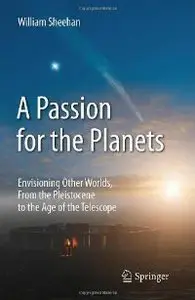William Sheehan, "A Passion for the Planets: Envisioning Other Worlds, From the Pleistocene to the Age of the Telescope"
English | 2010 | ISBN: 144195970X | 194 pages | PDF | 7,1 MB
English | 2010 | ISBN: 144195970X | 194 pages | PDF | 7,1 MB
Astronomy is by far the most popular of the physical sciences, enticing enough to become a major cultural preoccupation for many, and for some an enthralling scientific activity which veritably rules their lives.
What is the nature of that seemingly unstoppable attraction? In this lively and compelling account, William Sheehan – professional psychiatrist, noted historian of astronomy, and incurable observer - explores the nature of that allure through the story of man's visual exploration of the planets.
In this volume, the first of a trilogy, Sheehan starts with observational astronomy’s profound and lasting effect on his own life, setting the points of embarkation for the journey to come. He travels across the historical landscape seeking the earliest origins of man's compulsion to observe the planets among the hunter gatherers of the upper palaeolithic, and traces the evolving story from the planetary records of the earliest cities, to Pharonic Egypt through to Hellenistic Greek astronomy culminating in Ptolemy. The necessity to observe played its part in the perceptual changes wrought by the Copernican revolution, as well as the observational advances achieved by such extraordinary characters as Tycho with his sharpest of eyes, and his luxurious practice of total astronomy. The two epochal advances published in 1609, both born through planetary observation, namely Kepler's discovery of the true nature of the orbit of Mars and Harriot and Galileo’s observations of the Moon, have a pivotal place in this account.
Sheehan weaves a rich tapestry of social and technological settings, patronage and personalities, equipment and skills, cosmologies and goals, motives and compulsions to try to explain why we have observed, and continue to observe, the planets.
The compelling text of A Passion for the Planets is enhanced by the specially commissioned planetary artwork of Julian Baum, himself son of a noted planetary observer and historian of planetary observers, and Randall Rosenfeld.



